Team USA Goes to the
2006 ARDF World Championships
Primorsko, Bulgaria, September 12 - 17, 2006
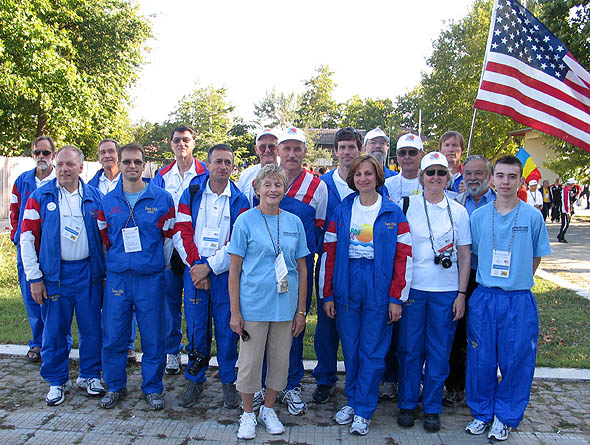
ARDF Team USA members and some visitors at the 2006 World Championships. Heads left to right are Bob Cooley, Dick Arnett, Jay Hennigan, Vadim Afonkin, Bob Frey, George Neal, Charles E. Scharlau III, Clydene Scharlau, Jerry Boyd, Charles Scharlau, Nadia Scharlau, Dale Hunt, Harley Leach, Karla Leach, Dave D'Epagnier, Marvin Johnston, Jay Thompson. (Photo courtesy Dave D'Epagnier KØQE)

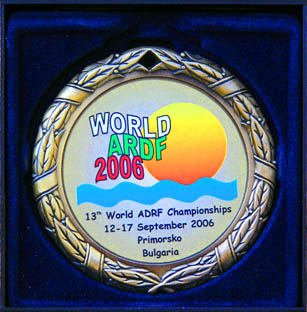 "These were the most difficult courses that I have ever seen!" That's how Charles Scharlau NZ0I described the 2006 World Championships of Amateur Radio Direction Finding (ARDF). Charles and his wife Nadia had just returned from Primorsko, on the Black Sea Coast of Bulgaria, where for the 13th time, the world's best on-foot transmitter hunters gathered to see who would capture gold, silver and bronze. The year 2006 marked the fifth time that stateside foxhunters have gone up against the rest of the world, and for the first time, the Stars and Stripes were raised on the podium during the awards ceremony.
"These were the most difficult courses that I have ever seen!" That's how Charles Scharlau NZ0I described the 2006 World Championships of Amateur Radio Direction Finding (ARDF). Charles and his wife Nadia had just returned from Primorsko, on the Black Sea Coast of Bulgaria, where for the 13th time, the world's best on-foot transmitter hunters gathered to see who would capture gold, silver and bronze. The year 2006 marked the fifth time that stateside foxhunters have gone up against the rest of the world, and for the first time, the Stars and Stripes were raised on the podium during the awards ceremony.
ARDF teams from European countries usually travel to international championships as a group. By contrast, Team USA members came from eight states and arrived in Bulgaria over a 6-day period. The closest major airport is in Sofia, necessitating a 7-hour bus ride cross-country to the coastal resort village of Primorsko. Only weeks before, its beaches had been blanketed with vacationing Europeans.
Seven Team USA members participated in training sessions provided by the Bulgarian organizers. For up to a week before the championships, they joined dozens of others who were working to improve their RDF and orienteering skills in woods and fields next to the Black Sea. Each day's training run was 5 to 7.5 miles with total climb of 350 to almost 1000 feet. Average daytime temperature was about 70 degrees Fahrenheit. NZØI wrote: "We discovered the joys of Bulgarian blackberry bushes. They tend to cover the clearings with about 18 inches of
growth, just low enough to fool one into thinking that it is easy to
run through them. Don't attempt it without iron gaiters on! The woods were
mostly pretty runnable, and a better choice over the deceptive clearings."
Unfortunately, some of the early arrivers encountered contaminated food in the cafeteria. On our team, Harley Leach, KI7XF and Vadim Afonkin came down with severe stomach and intestinal symptoms that lasted through the two-meter competition day.
The first formal competition was September 14 on two meters. The courses were a bus ride away from the coast and encompassed more than 4800 acres of well-mapped forests and fields. The shortest point-to-point distance for the full 5-fox course was 7.5 kilometers.
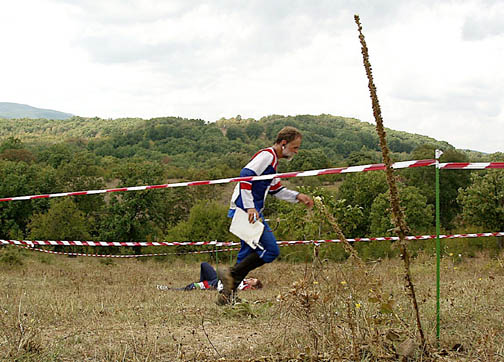 Bob Cooley KF6VSE (shown at left in 80m course photo by Jay Hennigan WB6RDV) finished ninth in the category for men over age 60, finding all three of his required foxes and missing a medal by less than three and a half minutes. "The first two foxes were easy, but #5 presented much more opportunity for error," Bob explains. "I should have gone northeast to bypass most of the medium green on the map and get on the trails going toward that fox. But I followed the bearing north and spent more time in the medium green than I should have."
Bob Cooley KF6VSE (shown at left in 80m course photo by Jay Hennigan WB6RDV) finished ninth in the category for men over age 60, finding all three of his required foxes and missing a medal by less than three and a half minutes. "The first two foxes were easy, but #5 presented much more opportunity for error," Bob explains. "I should have gone northeast to bypass most of the medium green on the map and get on the trails going toward that fox. But I followed the bearing north and spent more time in the medium green than I should have."
Bob continues, "Because of signal reflections, it is always a bad idea to hunt a two-meter fox from the bottom of a stream bed, but that is what I did next. I led four people into a dead-end clearing 150 meters northwest of #5. That would have been funny, except that I was in there too. I should have approached #5 on the higher trail that pointed right at it. This would have saved me more than one five-minute cycle."
Jay Hennigan WB6RDV finished 16th out of 42 in the category for men between 50 and 59. Jay has greatly improved since his first World Championship appearance in 2004. In addition to ARDF practice, he enters many classic orienteering meets to develop his map-and-compass skills.
"These were extremely tough courses, physically and mentally," noted NZ0I, who found his four required foxes in just under two hours. "The locations of the foxes made it difficult to select the optimum order. On one course, the top three finishers in one category each took the transmitters in different order. That is very unusual."
Charles discovered ARDF in the Puget Sound area of Washington State and competed in our national Championships for the first time in 2001. His wife Nadia learned ARDF as a youth in the Soviet Union and won her first gold medal by competing for USSR at the European Championships in 1984. Both of them represented USA at the last two World ARDF Championships, where Nadia was our team's top performer. In 2002, she took fourth place in her category on one band, finishing within two minutes of the bronze medallist.
In 2004, Nadia was again close to a medal when the battery fell out of her 80-meter receiver on the way to her final transmitter. Without it, she had to find the last fox and get to the finish using just her previously-marked bearings. The lost time put her in 11th place instead of perhaps earning a trip to the medal podium. Now on the first competition day in Bulgaria, Nadia finished 7th in her category, taking just ten minutes longer than the gold medallist to find her required four foxes.
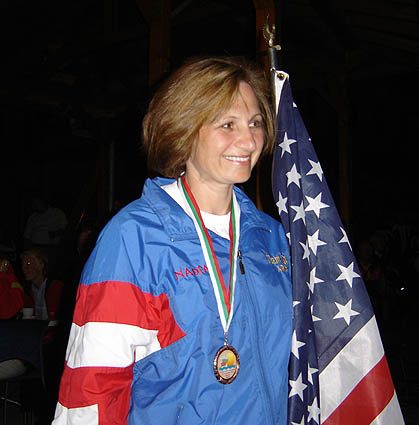 Nadia agreed with Charles that the two-meter event was very difficult, but she was happy about it. "I knew it would be to my benefit if the courses were hard," she said. "Hard courses favor mental skills over physical skills." Nadia usually places better on 80 meters than on two meters, so she was excited about her prospects for the next event.
Nadia agreed with Charles that the two-meter event was very difficult, but she was happy about it. "I knew it would be to my benefit if the courses were hard," she said. "Hard courses favor mental skills over physical skills." Nadia usually places better on 80 meters than on two meters, so she was excited about her prospects for the next event.
After a day of rest and touring, everyone climbed back on the bus for a ride to the 80m hunt on Saturday, when Nadia had to overcome adversity again. According to the electronic scoring records, she found her four required foxes in silver medal time, but just as she was ready to go to the end, the Bulgarians' finish corridor transmitter failed for about 15 minutes.
With no RDF help and no nearby roads on the map, Nadia had to navigate cross-country in the forest to find the finish. Even though she is a skilled orienteer, this put her at a severe disadvantage when compared to those before and after who could use the finish line fox to find the exact direction to go. Only two competitors in her category were headed for the finish in that time period and the other wasn't a medal contender. A protest was filed and, after an hour of deliberation, the international jury adjusted Nadia's time such that she tied for third place. (Podium photo at right by Richard Thompson WA6NOL)
USA's progress in ARDF is quite remarkable. Unlike some other countries, all Team USA members are true amateurs, who train mostly at home and pay their own way to all events. This includes Charles and Nadia.
"It was a very hot summer here, sometimes 100 degrees," says Nadia. "I tried to run five or six miles on the streets every day after work, but Charles and I didn't have many opportunities to go practice RDF in the woods because of the heat and humidity. Sometimes we would take a couple of transmitters to the park. He would hide one transmitter and I would hide the other one. As soon as I would find his, I would move it. He would do the same and we would repeat five or six times. By then we felt dead because of the heat."
All but three of the 13 competitors on Team USA 2006 earned their places at the 2006 USA ARDF Championships, held April 7 through 9 near Durham, North Carolina. The remainder qualified at the 2005 national championships near Albuquerque, New Mexico. Two of them were Charles and Nadia Scharlau, who were co-chairs of the organizers of the North Carolina championships. Also attending from the USA were two persons who served as members of the international jury.
USA's Delegation
NAME AND CALL CITY CATEGORY
Afonkin, Vadim Boston, MA M21
Arnett, Dick WB4SUV Erlanger, KY M60
Boyd, Gail Albuquerque, NM Visitor
Boyd, Jerry WB8WFK Albuquerque, NM M21
Cooley, Bob KF6VSE Pleasanton, CA M60
D'Epagnier, Dave K0QE Longmont, CO M40
Frey, Robert WA6EZV Cincinnati, OH M50
Hennigan, Jay WB6RDV Goleta, CA M50
Hunt, Dale WB6BYU Yamhill, OR M50
Johnston, Marvin KE6HTS Santa Barbara, CA Juror
Leach, Harley KI7XF Bozeman, MT M60
Leach, Karla KC7BLA Bozeman MT Juror
Neal, George KF6YKN Melrose, MA M40
Scharlau, Nadia Cary, NC W35
Scharlau, Charles NZ0I Cary, NC M40
Scharlau, Charles E. III Visitor
Scharlau, Clydene Visitor
Thompson, Jay W6JAY Santa Ana, CA M21
Thompson, Richard WA6NOL Santa Ana, CA Visitor
Here are the medal winners and Team USA performances for all age/gender categories in which USA competed:
Two-meters (140 minute time limit)
W35 (Females ages 35 and older, 29 in category, 4 required foxes)
Gold Lyubov Provatorova Russia 90:08 4 Foxes
Silver Jitka Simackova Czech 90:10 4 Foxes
Bronze Viktoria Tzenkova Bulgaria 94:54 4 Foxes
Nadia Scharlau ( 7th) USA 99:20 4 Foxes
- - - - -
M21 (Males of any age, 52 in category, 5 required foxes)
Gold Sergiy Shtanko Ukraine 62:56 5 Foxes
Silver Evgeny Panchenko Russia 64:55 5 Foxes
Bronze Dmytro Chumak Ukraine 73:38 5 Foxes
Vadim Afonkin (36th) USA 123:40 5 Foxes
Jay Thompson (46th) USA 127:41 3 Foxes
Jerry Boyd (Overtime) USA 140:36 1 Fox
Team USA 15th of 16 national teams
- - - - -
M40 (Males ages 40 and older, 53 in category, 4 required foxes)
Gold Valeriy Herashchenko Ukraine 62:16 4 Foxes
Silver Mykola Ivanchykhin Ukraine 65:21 4 Foxes
Bronze Daniel Nikolov Bulgaria 66:58 4 Foxes
George Neal (24th) USA 93:48 4 Foxes
Dave D'Epagnier (37th) USA 114:00 4 Foxes
Charles Scharlau (39th) USA 117:03 4 Foxes
Team USA 13th of 16 national teams
- - - - -
M50 (Males ages 50 and older, 42 in category, 4 required foxes)
Gold Tchermen Gouliev Russia 57:23 4 Foxes
Silver Vasyl Romanenko Ukraine 58:18 4 Foxes
Bronze Georgi Vodenicharov Bulgaria 68:16 4 Foxes
Jay Hennigan (16th) USA 94:35 4 Foxes
Bob Frey (37th) USA 125:54 3 Foxes
Dale Hunt (39th) USA 137:11 3 Foxes
Team USA 11th of 12 national teams
- - - - -
M60 (Males ages 60 and older, 51 in category, 3 required foxes)
Gold Viktor Korshunov Ukraine 60:24 3 Foxes
Silver Lev Korolev Russia 64:28 3 foxes
Bronze Josef Tuttmann Netherlands 71:37 3 foxes
Bob Cooley ( 9th) USA 75:00 3 Foxes
Harley Leach (28th) USA 95:33 3 Foxes
Dick Arnett (34th) USA 109:16 3 Foxes
Team USA 7th of 16 national teams
Eighty-meters (140 minute time limit)
W35 (Females ages 35 and older, 29 in category, 4 required foxes)
Gold Ljubov Prowatorowa Russia 72:31 4 Foxes
Silver Nataliya Shcherbatyuk Ukraine 77:24 4 Foxes
Bronze Nadia Scharlau USA 78:35 4 Foxes
Bronze Jitka Simackova Czech 78:35 4 Foxes
- - - - -
M21 (Males of any age, 53 in category, 5 required foxes)
Gold Jakub Oma Czech 58:19 5 Foxes
Silver Karel Fucik Czech 59:33 5 Foxes
Bronze Sergiy Shtanko Ukraine 61:40 5 Foxes
Vadim Afonkin (24th) USA 96:33 5 Foxes
Jerry Boyd (46th) USA 111:56 2 Foxes
Jay Thompson (Overtime) USA 150:07 4 Foxes
Team USA 14th of 15 national teams
- - - - -
M40 (Males ages 40 and older, 52 in category, 4 required foxes)
Gold Valeriy Herashchenko Ukraine 65:46 4 Foxes
Silver Mykhailo Puhach Ukraine 68:28 4 Foxes
Bronze Mykola Ivanchykhin Ukraine 69:27 4 Foxes
George Neal (14th) USA 86:07 4 Foxes
Dave D'Epagnier (27th) USA 108:04 4 Foxes
Charles Scharlau (41th) USA 135:19 4 Foxes
Team USA 8th of 16 national teams
- - - - -
M50 (Males ages 50 and older, 43 in category, 4 required foxes)
Gold Vasyl Romanenko Ukraine 66:34 4 Foxes
Silver Jiri Hruska Czech 68:09 4 Foxes
Bronze Tchermen Gouliev Russia 72:35 4 foxes
Jay Hennigan (20th) USA 114:10 4 Foxes
Dale Hunt (Overtime) USA 145:38 2 Foxes
Bob Frey (Overtime) USA 153:39 4 Foxes
- - - - -
M60 (Males ages 60 and older, 51 in category, 3 required foxes)
Gold Viktor Korshunov Ukraine 59:54 3 Foxes
Silver Gunnar Svensson Sweden 73:07 3 foxes
Bronze Paul Rudolf Switzerland 74:14 3 foxes
Bob Cooley (14th) USA 85:36 3 Foxes
Harley Leach (28th) USA 104:35 3 Foxes
Dick Arnett (35th) USA 114:49 3 Foxes
Team USA 7th of 14 national teams
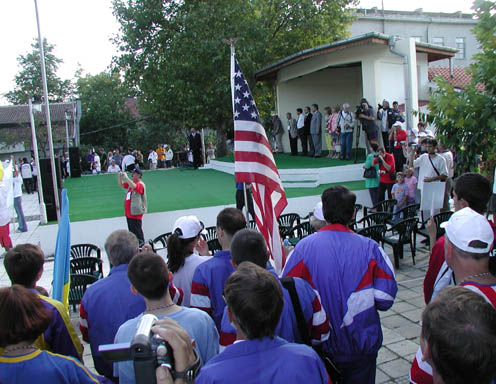
In their red, white and blue jackets, Team USA members stand behind the Stars and Stripes during opening ceremonies on September 13, 2006. (Photo by Charles Scharlau NZØI)
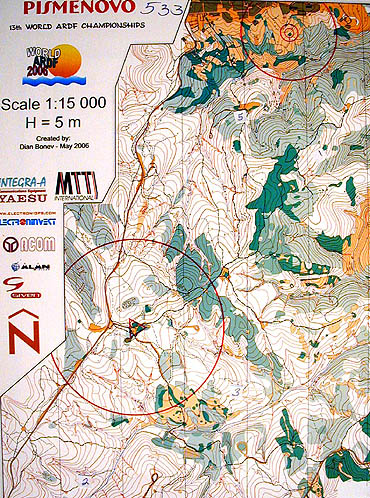
Map of the two-meter competition.
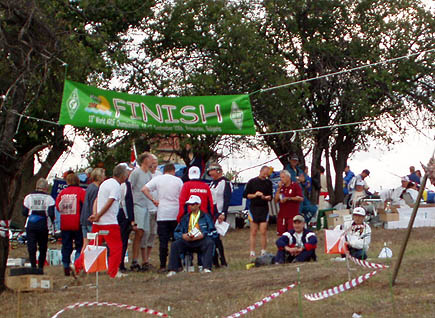
Competitors and visitors wait in the two-meter finish area for more incoming runners, who had to run over 500 feet uphill through the final corridor. (Photo by Jay Hennigan WB6RDV)
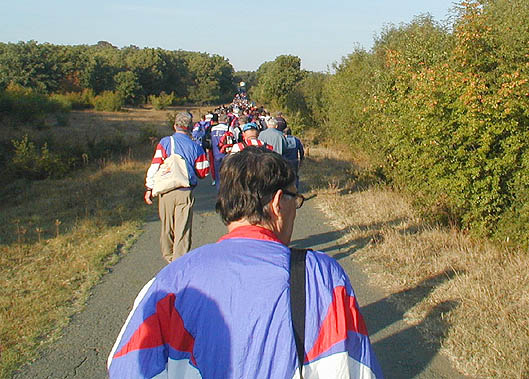
A long line of competitors heads out from the bus to the 80-meter start area. (Photo by Jay Hennigan WB6RDV)
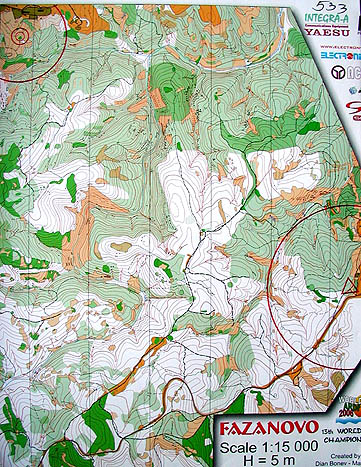
Map of the eighty-meter competition.
Portions of the report above have been excerpted from my Homing In column in the Fall 2006 issue of CQ-VHF Magazine.
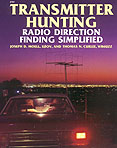
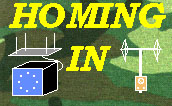 Go to the Championship Foxhunting News page
Go to the Championship Foxhunting News page
Back to the Homing In home page
This page updated 23 September 2016


 "These were the most difficult courses that I have ever seen!" That's how Charles Scharlau NZ0I described the 2006 World Championships of Amateur Radio Direction Finding (ARDF). Charles and his wife Nadia had just returned from Primorsko, on the Black Sea Coast of Bulgaria, where for the 13th time, the world's best on-foot transmitter hunters gathered to see who would capture gold, silver and bronze. The year 2006 marked the fifth time that stateside foxhunters have gone up against the rest of the world, and for the first time, the Stars and Stripes were raised on the podium during the awards ceremony.
"These were the most difficult courses that I have ever seen!" That's how Charles Scharlau NZ0I described the 2006 World Championships of Amateur Radio Direction Finding (ARDF). Charles and his wife Nadia had just returned from Primorsko, on the Black Sea Coast of Bulgaria, where for the 13th time, the world's best on-foot transmitter hunters gathered to see who would capture gold, silver and bronze. The year 2006 marked the fifth time that stateside foxhunters have gone up against the rest of the world, and for the first time, the Stars and Stripes were raised on the podium during the awards ceremony.
 Bob Cooley KF6VSE (shown at left in 80m course photo by Jay Hennigan WB6RDV) finished ninth in the category for men over age 60, finding all three of his required foxes and missing a medal by less than three and a half minutes. "The first two foxes were easy, but #5 presented much more opportunity for error," Bob explains. "I should have gone northeast to bypass most of the medium green on the map and get on the trails going toward that fox. But I followed the bearing north and spent more time in the medium green than I should have."
Bob Cooley KF6VSE (shown at left in 80m course photo by Jay Hennigan WB6RDV) finished ninth in the category for men over age 60, finding all three of his required foxes and missing a medal by less than three and a half minutes. "The first two foxes were easy, but #5 presented much more opportunity for error," Bob explains. "I should have gone northeast to bypass most of the medium green on the map and get on the trails going toward that fox. But I followed the bearing north and spent more time in the medium green than I should have."
 Nadia agreed with Charles that the two-meter event was very difficult, but she was happy about it. "I knew it would be to my benefit if the courses were hard," she said. "Hard courses favor mental skills over physical skills." Nadia usually places better on 80 meters than on two meters, so she was excited about her prospects for the next event.
Nadia agreed with Charles that the two-meter event was very difficult, but she was happy about it. "I knew it would be to my benefit if the courses were hard," she said. "Hard courses favor mental skills over physical skills." Nadia usually places better on 80 meters than on two meters, so she was excited about her prospects for the next event.






